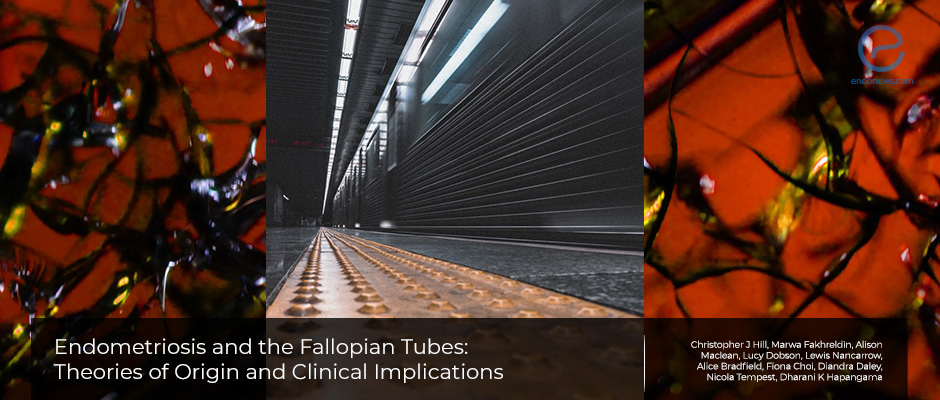Fallopian tubes and endometriosis
Jul 29, 2020
Oviducts are the main road for the endometrial spreading that might establish connections to ovarian endometrioma and cancer.
Key Points
Highlights:
- Findings suggest that both endometrium and tubal mucosa contribute to the origin of endometriosis and endometrial lesions may cause tubal dysfunction that might play a role in the further development of the disease.
Importance:
- Both uterus and fallopian tubes are derived from embryonic paramesonephric (Mullerian) duct, thus share common features in cell types and progenitors, that also exist in endometriosis lesions.
What's done here:
- This review summarises the available evidence for the contribution of fallopian tubes to the origin, pathogenesis, symptoms, and clinical consequences of endometriosis.
Facts based on data:
- Causes of tubal dysfunction in endometriosis are inflammation, tubal obstruction, adhesions, and hydrosalpinx.
- Consequences of endometriosis-associated with tubal dysfunction may lead to subfertility, pelvic pain, and ectopic pregnancy.
- Ninety % of ovarian cancers are epithelial in nature and endometriosis has been linked to clear-cell and endometrioid subtypes.
- Tubal ligation is well-known to reduce the risk of ovarian cancer by 20-40%, especially the clear-cell and endometrioid types supporting the theory that these cancers are coming through the fallopian tubes.
- On the other hand, removal of the fimbrial end of FT has been shown more effectively to reduce the prevalence of high-grade serous cancers which directly originate from fallopian tube epithelium.
Lay Summary
There are multiple theories to explain the pathogenesis of endometriosis, among which the most popular one is Sampson's retrograde menstruation theory. The role of endometrial stem cells/progenitors are widely studied to support the origin of ectopic lesions in recent decades. Despite the spreading of endometrial tissue into the peritoneal space through the fallopian tubes, is the key event for retrograde shedding theory; however, the contributions of Fallopian tubes to endometriosis are rarely discussed.
Hill et al., from the Centre of Women Health Research, University of Liverpool, UK, penned a review to reveal the role of oviducts and their contribution to ovarian endometriosis and ovarian cancer was recently published in the "Journal of Clinical Medicine".
İn their review, the authors emphasized the topics below and utilized them to reveal the contribution of endometriosis to the progression of ovarian endometrioma and ovarian cancers.
The three different ways postulated to develop the tubal endometriosis are; i) invasion of endometrial implants into the tubal serosa and subserosa, ii) the invasion, and the replacement of tubal mucosa by endometrial tissue, iii) endometriosis which develops in the proximal residual segment of FT after salpingectomy operations.
Although endometrium and fallopian tubes are arising from the same origin in embryologic life, tubal epithelial cells are less responsive to hormonal effects than the endometrium. The prevalence of tubal endometriosis is related to the severity of endometriosis. Furthermore, tubal occlusion and salpingectomy increase the risk of developing tubal endometriosis and facilitate the improvement of pelvic endometriosis depending on the interruption of oral contraceptives after tubal ligation.
On the other hand, tubal ligation, known to reduce the risk of ovarian cancer 20-40%, that applies to the clear-cell and endometrioid types of ovarian cancers, supporting the theory that these cancers are coming through the fallopian tubes; whereas sterilization with the removal of the fimbrial end is more effective at risk reduction as high-grade serous type ovarian cancers originate from the fimbrial part of the fallopian tubes.
"The above pieces of evidence that link fallopian tubes and their contribution to ovarian endometriosis and ovarian cancer; and interesting findings suggesting the contribution of the fallopian tubes to the genesis and the symptomatology of endometriosis necessitates further research for understanding the differential cellular subtypes, characterizing the context of these cell subtypes, and to further to perceive the origin of the disease as well as more suitable lesion type-specific treatments", researchers concluded.
Research Source: https://pubmed.ncbi.nlm.nih.gov/32570847/
reactif oxygen species (ROS) pathogenesis retrograde menstruation stem cells fallopian tubes tubal ligation ovarian cancer ECOG endometriosis stage 3 stages

